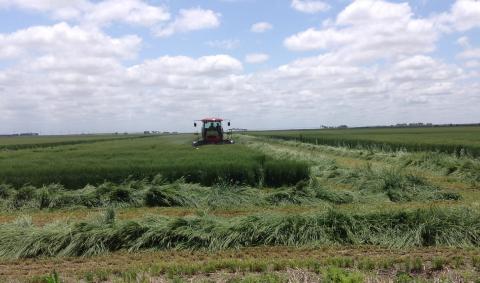Planting Forages after Wheat Harvest
June 21, 2018
After wheat harvest, don't let your ground stand idle, especially if you could use more forage. When moisture is available, there are a number of forage options to consider following wheat.
Related UNL AgNews
May 25, 2018
UNL Research: Land-cover Changes likely Intensified Dust Bowl Drought | Blanco Leads 3-Year Cover Crop Study funded by Nebraska Environmental Trust | Grass-Cast, a New Experimental Grassland Productivity Forecast, Predicts Available Forage
Wheat Forage Options and Considerations
May 17, 2018
This spring many Nebraska livestock producers facing low forage supplies may be looking for new sources, such as from wheat. This Nebraska research on harvest timing suggests how to optimize feed value from wheat forage.
Scouting Recommended in Wheatgrass for Black Grass Bugs
April 27, 2018
In western Nebraska when wheatgrass, especially crested wheatgrass, starts growing, it’s time to begin monitoring for black grass bugs. Feeding damage caused by these insects can substantially reduce wheatgrass forage production.
Plan Herbicide Use Now to Allow for Annual Forages Later
March 29, 2018
Don't limit your planting options later due to your herbicide selection this spring. Consider whether you can control weeds and maintain the flexibility to plant any forage later just by making a small change in the herbicides you use now.

April 4 Conference to Focus on Capturing Value of Cover Crops as Forages
March 7, 2018
A Nebraska Extension conference and field day, “Capturing Value in Cropping Systems using Cattle,” will offer a unique learning and networking opportunity for cattle and crop producers in eastern Nebraska.
Does Seeding Rate Affect Establishment-Year Growth and Long-term Forage Yield of Indiangrass?
February 5, 2018
Recent improvements in forage yield and nutritive value of indiangrass, along with its wide range of adaptation should increase its use in bioenergy and forage production, conservation practices, and reclamation projects in the central Great Plains. This study tested five seeding rates with two varieties — 'Oto' and 'NE 54' — and the effects on dry matter production
Economics of Annual and Perennial Forages Webinar Feb. 13
February 4, 2018
With current corn prices and the limited availability of perennial grass, some producers are asking themselves if growing forages on cropland might be the answer to feeding the cow herd. A webinar to address these questions in addition to showing economic examples will be held Tuesday evening, February 13, from 6:00-7:30 p.m. CST.


